-
ORIGINAL ARTICLE10-24-2022
Development and testing of the Prev’Quedas game for older adults in the community: a descriptive study
Revista Brasileira de Enfermagem. 2022;75:e20220098
Abstract
ORIGINAL ARTICLEDevelopment and testing of the Prev’Quedas game for older adults in the community: a descriptive study
Revista Brasileira de Enfermagem. 2022;75:e20220098
DOI 10.1590/0034-7167-2022-0098
Views0See moreABSTRACT
Objectives:
to develop and test a board game for fall prevention in older adults in the community.
Methods:
a descriptive study, carried out through the use of game design elements (narrative, mechanics, aesthetics and technology), the Health Promotion Model, assessment by experts and testing with older adults. For assessment, the Concordance Index was used, considering it greater than 80%.
Results:
three prototypes and the final version were developed. The game’s narrative was based on promotion model, comprising individual aspects, benefits and barriers in behavior to prevent falls. The mechanics outlined goals and rules. Aesthetics encompassed layout and illustrations. The technology involved board, cards, pin, roulette and instruction manual. The game was assessed by 36 experts and 31 older women from the community, with a Concordance Index of 93.22% and 99%, respectively.
Conclusions:
the game developed and tested was considered an adequate educational strategy for fall prevention.

-
ORIGINAL ARTICLE10-24-2022
Factors associated with symptoms of physical and emotional burden in informal caregivers of the elderly
Revista Brasileira de Enfermagem. 2022;75:e20210927
Abstract
ORIGINAL ARTICLEFactors associated with symptoms of physical and emotional burden in informal caregivers of the elderly
Revista Brasileira de Enfermagem. 2022;75:e20210927
DOI 10.1590/0034-7167-2021-0927
Views1See moreABSTRACT
Objectives:
to analyze the personal and work-related burden factors associated with physical and emotional symptoms of informal caregivers of the elderly.
Methods:
cross-sectional study conducted with 121 informal caregivers and 121 seniors who received care, assessed individually for the risk of: physical overload, musculoskeletal symptoms, Self-Reporting Questionnaire, effort perception, and Katz index.
Results:
a greater perception of effort raises up to 3.3 times the chances of presenting symptoms of pain in the spine region (p=0.01), and lower functional capacity of the elderly increases up to 1.3 times the chances of presenting pain symptoms in the spine region (p=0.02). The symptoms of emotional overload were associated with the caregiver’s low income (p=0.02).
Conclusions:
the perception of effort, dependence of the elderly, caregiver’s age, and symptoms of emotional overload are involved with caregivers’ symptoms of physical overload, and low income, with emotional overload.
-
10-24-2022
Fatores associados aos sintomas de sobrecarga física e emocional em cuidadores informais de idosos
Revista Brasileira de Enfermagem. 2022;75:e20210927
Abstract
Fatores associados aos sintomas de sobrecarga física e emocional em cuidadores informais de idosos
Revista Brasileira de Enfermagem. 2022;75:e20210927
DOI 10.1590/0034-7167-2021-0927
Views0See moreRESUMEN
Objetivos:
analizar factores de sobrecarga personal y relacionados al trabajo relacionados a síntomas físicos y emocionales de cuidadores informales de ancianos.
Métodos:
estudio transversal realizado con 121 cuidadores informales y 121 ancianos que reciben cuidados, evaluados individualmente por riesgo de sobrecarga física, síntomas musculoesqueléticos, Self-Reporting Questionnaire, percepción de esfuerzo e Índice de Katz.
Resultados:
una mayor percepción del esfuerzo aumenta hasta 3,3 veces las chances de presentar síntomas de dolor en la región de la columna vertebral (p=0,01), y la menor capacidad funcional del anciano aumenta hasta 1,3 vez las chances de presentar síntomas de dolor en la región de la columna vertebral (p=0,02). Los síntomas de sobrecarga emocional presentaron relación a baja renta del cuidador (p=0,02).
Conclusiones:
la percepción del esfuerzo, dependencia del anciano, edad del cuidador y síntomas de sobrecarga emocional están involucrados a síntomas de sobrecarga física de cuidadores; y baja renta, con síntomas de sobrecarga emocional.
-
EXPERIENCE REPORT10-24-2022
Epistemological challenges of indigenous people’s research: reflections based on experience with conceptual map
Revista Brasileira de Enfermagem. 2022;75:e20220019
Abstract
EXPERIENCE REPORTEpistemological challenges of indigenous people’s research: reflections based on experience with conceptual map
Revista Brasileira de Enfermagem. 2022;75:e20220019
DOI 10.1590/0034-7167-2022-0019
Views0See moreABSTRACT
Objectives:
to discuss the applicability of the conceptual map and its underlying theoretical anchors and analyze the challenges and potentialities of this method concerning the participation of Indigenous Peoples.
Methods:
experience report of the use of the conceptual map as a data collection instrument.
Results:
the study allowed us to discuss the epistemic approaches and distances, as well as to analyze to what extent the conceptual map favored the process of joint production of knowledge with Indigenous Peoples. The experience with this type of research design also revealed epistemological challenges that reflect the established historical relationships, whose overcoming implies the construction of new forms of egalitarian and intercultural scientific relations.
Final Considerations:
the conceptual map theoretically composes a structured participatory methodology, which enables data collection and the collective construction of knowledge, provided that the cultural, epistemic, social, and political diversities of all the social actors involved are considered.
-
EXPERIENCE REPORT10-24-2022
Public policy for social inclusion in higher education and extension practices with ethnic groups
Revista Brasileira de Enfermagem. 2022;75:e20210970
Abstract
EXPERIENCE REPORTPublic policy for social inclusion in higher education and extension practices with ethnic groups
Revista Brasileira de Enfermagem. 2022;75:e20210970
DOI 10.1590/0034-7167-2021-0970
Views0See moreABSTRACT
Objectives:
to report the experience on the operationalization of a university extension project with and for training affirmative action students.
Methods:
an experience report with a descriptive approach on the operationalization of a university extension project for training affirmative action students, between 2020 and 2021, based on blended-learning and Activity Theory.
Results:
we carried out 103 activities, including actions for product development, media maintenance and targeted study of themes. They involved 13 students from two institutions, two leaders from ethnic groups and eight instructors.
Final Considerations:
collaborative relationships provided the exchange of knowledge about public health policies, educational technologies and social media, reducing deficits in the use of technological resources and application in health education. The activities promoted students’ leading role coming from affirmative action, in a representative way, from their experiences and needs, being potential for equitable training.
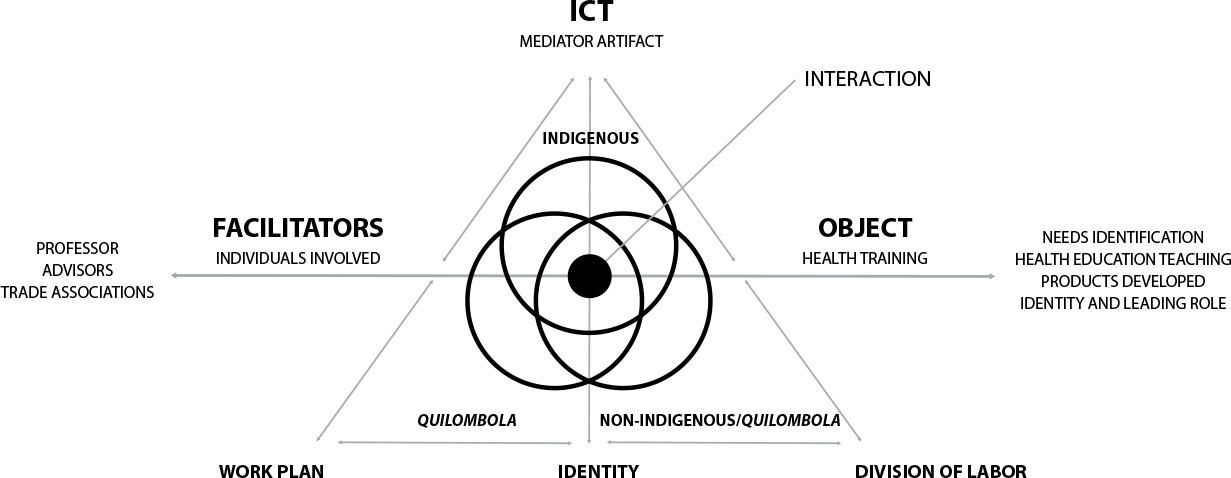
-
EXPERIENCE REPORT10-24-2022
Nursing process for elderly women susceptible to falls from the perspective of the Pender’s Model
Revista Brasileira de Enfermagem. 2022;75:e20210913
Abstract
EXPERIENCE REPORTNursing process for elderly women susceptible to falls from the perspective of the Pender’s Model
Revista Brasileira de Enfermagem. 2022;75:e20210913
DOI 10.1590/0034-7167-2021-0913
Views0See moreABSTRACT
Objectives:
to describe the strategy of applying the nursing process guided by Pender’s Health Promotion Model to elderly women susceptible to falls with a view to promoting a self-efficacy behavior for fall prevention.
Methods:
application of the nursing process to eleven elderly women who had already experienced falls, living in a neighborhood in the outskirts of Belem, state of Pará, which involved interviews to obtain their nursing history and group meetings using the focus group technique to develop the other phases of the nursing process: nursing diagnosis, nursing interventions, and nursing assessment.
Results:
despite the risk factors for falls, the intervention model adopted in this study allowed elderly women to enhance their self-efficacy.
Final Considerations:
the model proved to be suitable for the participation of elderly women in actions to build fall prevention behaviors, with a view to healthier lifestyles.

-
10-21-2022
Cancer symptom clusters: from the lab bench to clinical practice
Revista Brasileira de Enfermagem. 2022;75(5):e2022v75n5inov
Abstract
Cancer symptom clusters: from the lab bench to clinical practice
Revista Brasileira de Enfermagem. 2022;75(5):e2022v75n5inov
DOI 10.1590/0034-7167-2022v75n5inov
Views0See moreABSTRACT
Objective:
to present and discuss the advancement of science in symptom management through research involving oncological symptom clusters (OSC).
Method:
a reflective study, supported by the scientific literature on OSC.
Results:
five key points are crucial to advancing the science of symptom management through research involving OSC: definition of OSC characteristics; underlying mechanisms and priority symptom clusters; OSC measurement; targeted and personalized interventions; new analytical strategies.
Final considerations:
a better understanding of the complex connections between different systems and biobehavioral aspects in patients, especially in the field of oncology nursing, is urgent. The study of these interactions has become increasingly promising and emerging for oncology nursing, since therapeutic interventions, whose target is the neuroimmunoendocrine axis, are relevant for personalized care, translating into greater scientific and nurse autonomy to care for patients.
-
ORIGINAL ARTICLE10-21-2022
Technology for nursing consultation with transsexual women in the light of Leininger’s transcultural theory
Revista Brasileira de Enfermagem. 2022;75(5):e20210769
Abstract
ORIGINAL ARTICLETechnology for nursing consultation with transsexual women in the light of Leininger’s transcultural theory
Revista Brasileira de Enfermagem. 2022;75(5):e20210769
DOI 10.1590/0034-7167-2021-0769
Views0See moreABSTRACT
Objective:
to describe the construction and validation of a nursing consultation technology for transgender women.
Methods:
a methodological study developed in three stages with construction based on the Leininger’s Cross-Cultural Theory, content validation performed by experts in transgender sexual health and evaluation by nurses of care for transgender women. Items with a minimum agreement of 80% were considered validated, according to the Content Validity Index and binomial test.
Results:
the technology contains 59 items in three blocks: the first, for identification of the transsexual woman; the second, with the Clinical Data; and the third, regarding the Propaedeutics of Care. All items reached agreement higher than 0.8 and an overall Validity Index of 80%.
Conclusions:
the technology was content-validated and evaluated by nurses and can be applicable in clinical and outpatient practice as well as in academia to promote quality care for transgender women.
-
REVIEW06-01-2020
Access of the black population to health services: integrative review
Revista Brasileira de Enfermagem. 2020;73(4):e20180834
Abstract
REVIEWAccess of the black population to health services: integrative review
Revista Brasileira de Enfermagem. 2020;73(4):e20180834
DOI 10.1590/0034-7167-2018-0834
Views1See moreABSTRACT
Objectives:
demonstrate and discuss how the black population’s access to health services occurs
Methods:
integrative literature review with the following question: How does the black population’s access to health services occur? The search was carried out in the Scholar, LILACS and SciELO databases and used the descriptor “access to health services” and the term “population,” resulting in a sample with twelve articles.
Results:
studies show that the difficulty of access is a fundamental factor for the quality of life of people, directly compromising preventive services, especially for women’s health and, in addition, it has significant impact on the illness process of the black population within its particularities.
Final Considerations:
several limiting factors compromise the black population’s access to health services, including institutional and structural factors

-
REVIEW11-06-2020
Transitional care to caregivers of dependent older people: an integrative literature review
Revista Brasileira de Enfermagem. 2020;73:e20200394
Abstract
REVIEWTransitional care to caregivers of dependent older people: an integrative literature review
Revista Brasileira de Enfermagem. 2020;73:e20200394
DOI 10.1590/0034-7167-2020-0394
Views1See moreABSTRACT
Objective:
To identify the needs of caregivers of dependent older people related to self-care in the transition from hospital to home.
Methods:
Integrative literature review that followed a predefined protocol, carried out from March to May 2019 in the platforms EBSCO, B-On, Scopus, Web of Science, and Joanna Briggs Institute. Descriptors and eligibility criteria were defined for the bibliographic sample, which was ten articles. The search was limited to articles published between 2015 and 2019 to guarantee evidence topicality.
Results:
The needs of caregivers related to transitional care can be grouped into five categories: needs in the transition into the role of caregiver; needs related to self-care of caregivers themselves; health needs; economic needs; and social and collective needs.
Final considerations:
The work developed by nurses regarding transitional care of caregivers must have two focuses: managing care provided to dependent older people and managing the needs of caregivers and the care offered to them.
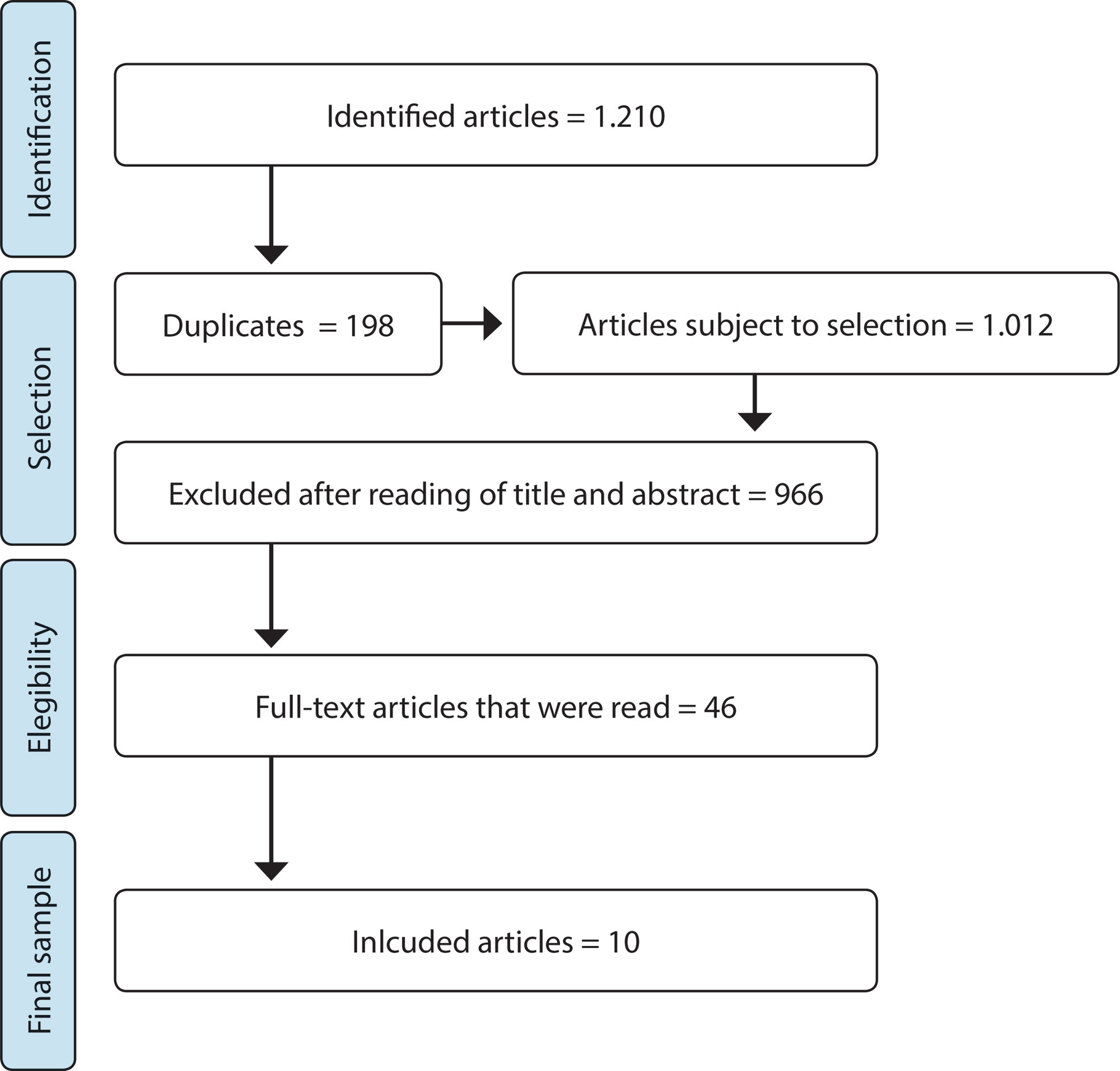
-
REVIEW10-19-2020
Validation methods of nursing protocols: an integrative review
Revista Brasileira de Enfermagem. 2020;73:e20200050
Abstract
REVIEWValidation methods of nursing protocols: an integrative review
Revista Brasileira de Enfermagem. 2020;73:e20200050
DOI 10.1590/0034-7167-2020-0050
Views0See moreABSTRACT
Objective:
to identify scientific production about validation methods of nursing care protocols.
Method:
an integrative review with search at Scielo, Pubmed/MEDLINE, Virtual Health Library, Web of Science, Scopus, and EBSCOhost. The descriptors “validation studies”, “validation studies as topic”, “protocols”, “clinical protocols”, “practice guidelines as topic”, “nursing” and “nursing assessment” and the uncontrolled descriptor “validation” were used.
Results:
thirty-two articles were selected, most of them Brazilian. Content validation by experts was the most frequent method, with no consensus on the number of participants for the process. The collection instruments were mostly created by the authors. Data analysis was performed using descriptive statistics and Content Validity Index, with a variable consensus rate in the analyzed articles.
Conclusion:
protocols validated by experts are robust tools for use in clinical practice, with methodological rigor in development essential for its quality.
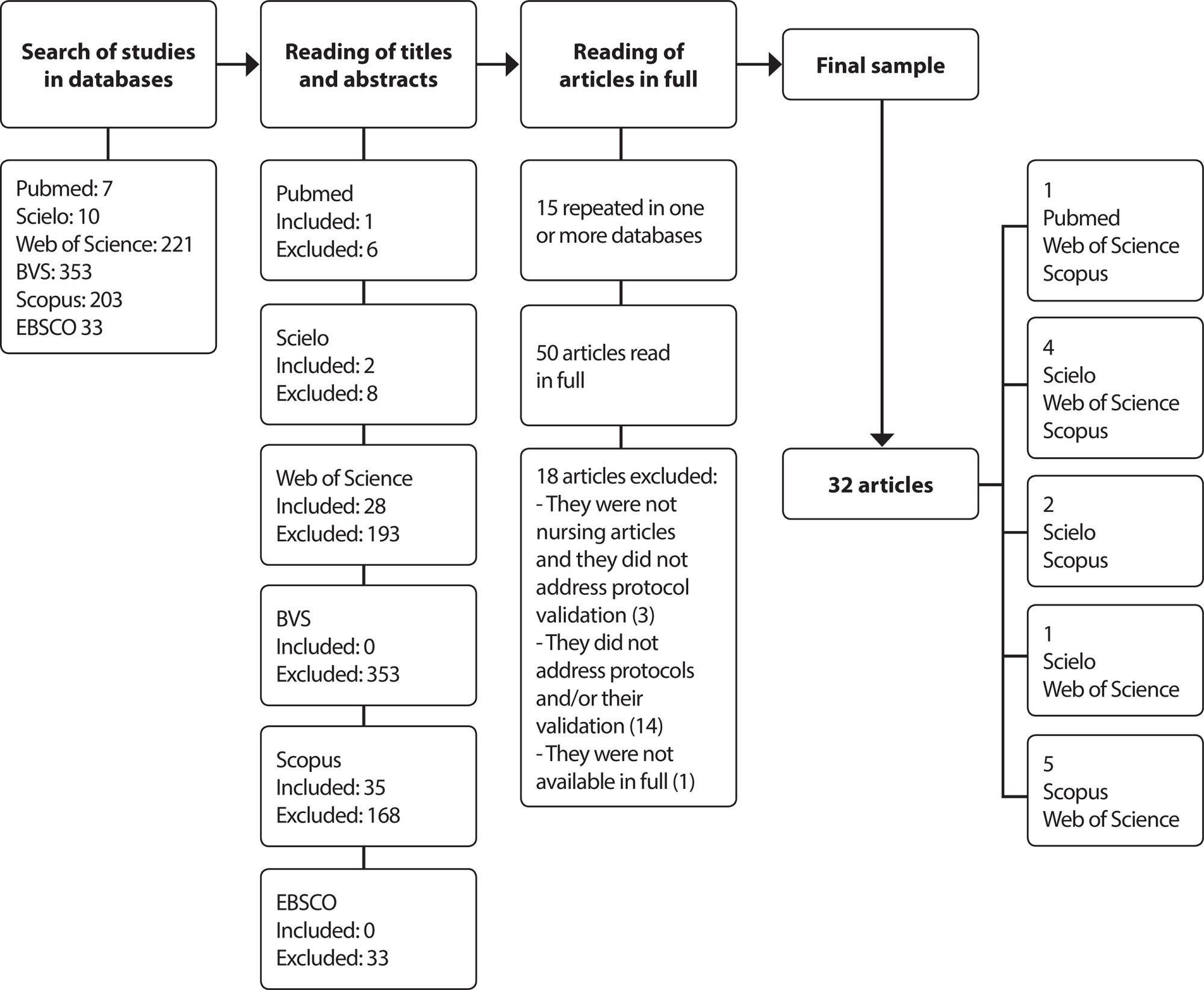
-
ORIGINAL ARTICLE05-24-2021
PEDCARE: validation of a mobile application on diabetic foot self-care
Revista Brasileira de Enfermagem. 2021;74:e20200856
Abstract
ORIGINAL ARTICLEPEDCARE: validation of a mobile application on diabetic foot self-care
Revista Brasileira de Enfermagem. 2021;74:e20200856
DOI 10.1590/0034-7167-2020-0856
Views0See moreABSTRACT
Objective:
to describe the process of validating a multimedia application on a mobile platform to promote foot care for people with diabetes.
Method:
a technological production and methodological type study. Content and appearance were validated by 39 judges (29 nursing judges and ten information and communication technology judges and 15 people from the target audience).
Results:
nursing judges made it possible to validate the material with a total Content Validity Index of 0.95, a non-significant binomial test for most items and Cronbach’s alpha of 0.92, information and communication technology judges with Suitability Assessment of Materials of 99.2% and the target audience with an agreement index of 98%.
Conclusion:
the application proved to be valid and reliable for use in clinical practice as an educational technology to promote foot care for people with diabetes.
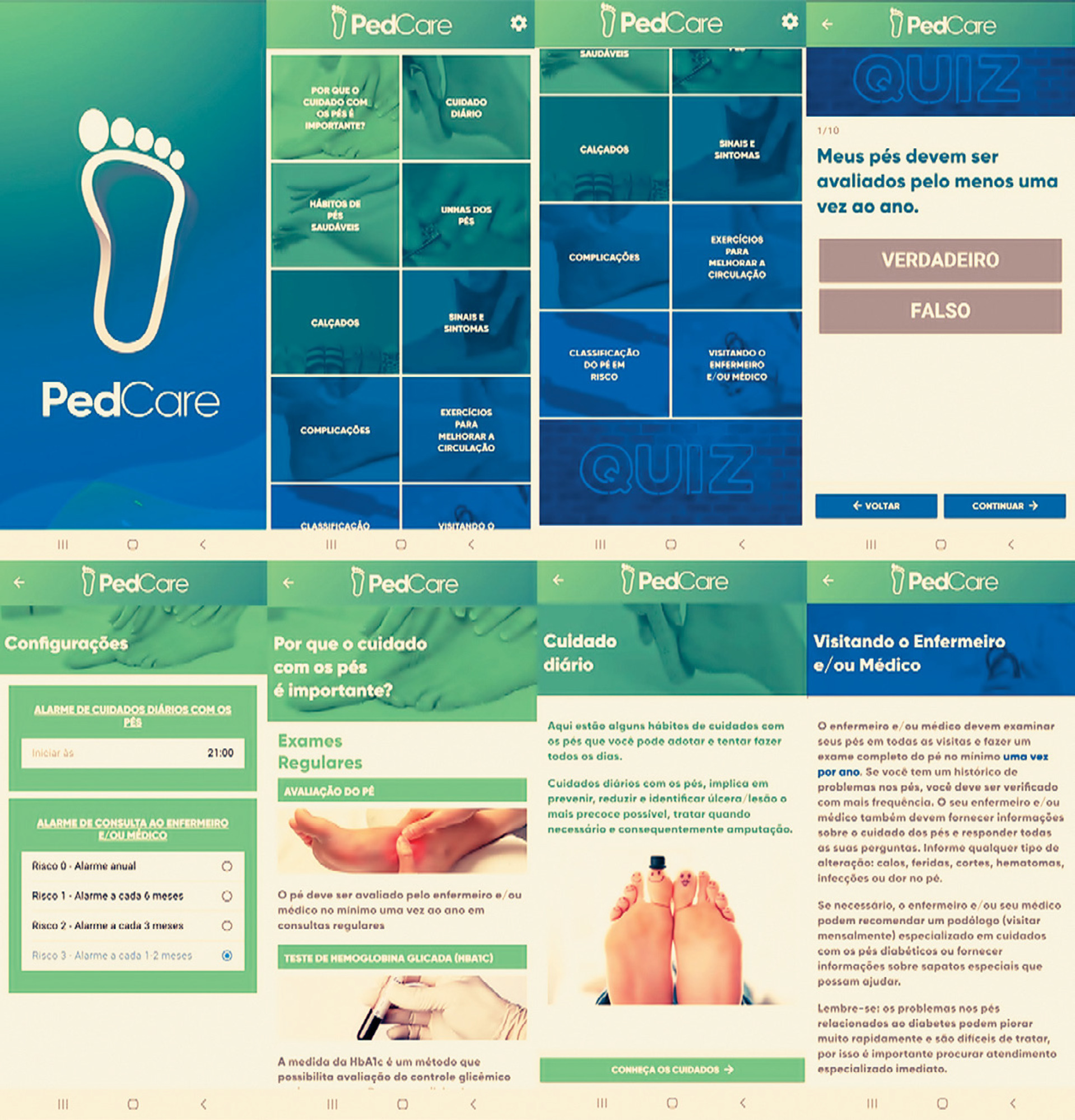
-
EXPERIENCE REPORT04-09-2020
Implementation of an Artificial Intelligence Algorithm for sepsis detection
Revista Brasileira de Enfermagem. 2020;73(3):e20180421
Abstract
EXPERIENCE REPORTImplementation of an Artificial Intelligence Algorithm for sepsis detection
Revista Brasileira de Enfermagem. 2020;73(3):e20180421
DOI 10.1590/0034-7167-2018-0421
Views0See moreABSTRACT
Objectives:
to present the nurses’ experience with technological tools to support the early identification of sepsis.
Methods:
experience report before and after the implementation of artificial intelligence algorithms in the clinical practice of a philanthropic hospital, in the first half of 2018.
Results:
describe the motivation for the creation and use of the algorithm; the role of the nurse in the development and implementation of this technology and its effects on the nursing work process.
Final Considerations:
technological innovations need to contribute to the improvement of professional practices in health. Thus, nurses must recognize their role in all stages of this process, in order to guarantee safe, effective and patient-centered care. In the case presented, the participation of the nurses in the technology incorporation process enables a rapid decision-making in the early identification of sepsis.
-
REVIEW03-24-2021
Development of clinical competence in nursing in simulation: the perspective of Bloom’s taxonomy
Revista Brasileira de Enfermagem. 2021;74(1):e20200135
Abstract
REVIEWDevelopment of clinical competence in nursing in simulation: the perspective of Bloom’s taxonomy
Revista Brasileira de Enfermagem. 2021;74(1):e20200135
DOI 10.1590/0034-7167-2020-0135
Views0See moreABSTRACT
Objectives:
to investigate the scientific evidence on the use of Bloom’s taxonomy for developing competence in nursing professionals and students in clinical simulation.
Methods:
integrative review of the National Library of Medicine (NLM), National Institutes of Health (NIH), Cumulative Index to Nursing and Allied Health Literature (CINAHL), Latin American and Caribbean Literature in Health Sciences (LILACS), Web of Science and SCOPUS databases, using the Rayyan application.
Results:
a total of 871 studies were identified; four composed the sample. The development of clinical competence occurred through the coordination of knowledge, skills, and attitudes. To develop the cognitive domain, the objectives of knowledge and comprehension of the Bloom’s taxonomy were mobilized. The psychomotor domain required development of the skills demanded by the proposed clinical care. The affective domain was developed through will and motivation to learn.
Conclusions:
it is possible to develop clinical competence in nursing by adopting Bloom’s taxonomy in each phase of clinical simulation.
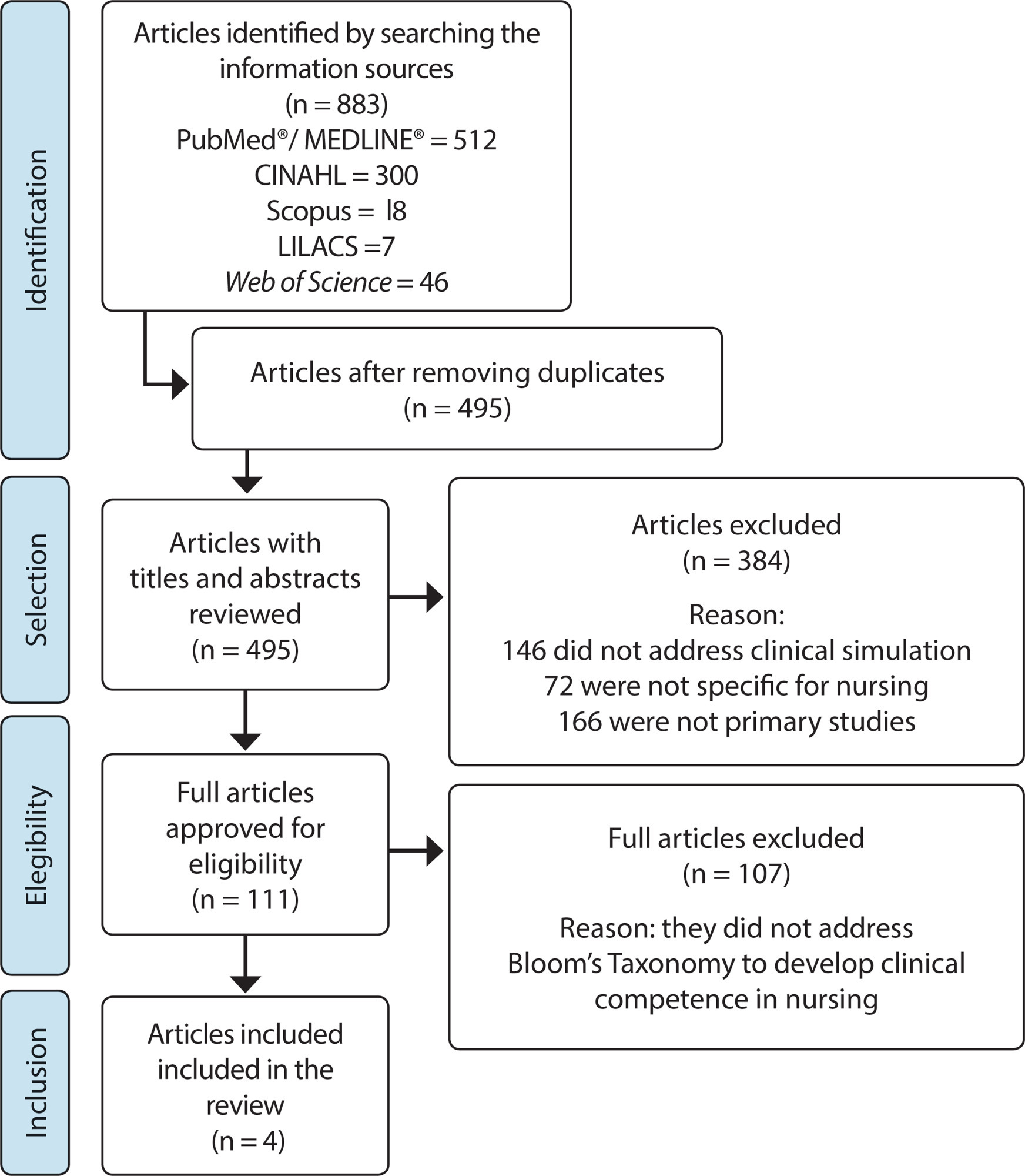
-
03-27-2020
Coronavirus 2020
Revista Brasileira de Enfermagem. 2020;73(2):e2020n2
Abstract
Coronavirus 2020
Revista Brasileira de Enfermagem. 2020;73(2):e2020n2
DOI 10.1590/0034-7167-2020730201
Views0Emerging and reemerging infectious diseases are constant challenges for public health worldwide. Recent cases of pneumonia of unknown cause in Wuhan, China, have led to the discovery of a new type of Coronavirus (2019-nCoV), which are enveloped RNA viruses, commonly found in humans, other mammals and birds, capable of causing respiratory, enteric, hepatic, and neurological […]See more -
ORIGINAL ARTICLE12-13-2019
Accessibility of children with special health needs to the health care network
Revista Brasileira de Enfermagem. 2019;72:65-71
Abstract
ORIGINAL ARTICLEAccessibility of children with special health needs to the health care network
Revista Brasileira de Enfermagem. 2019;72:65-71
DOI 10.1590/0034-7167-2017-0899
Views0See moreABSTRACT
Objective:
To know how children with special health needs access the health care network.
Method:
This is a qualitative research of descriptive-exploratory type, developed using semi-structured interviews mediated by the Talking Map design. Participants were 19 family caregivers of these children in two Brazilian municipalities. Data were submitted to inductive thematic analysis.
Results:
Difficulties were mentioned from the diagnosis moment to the specialized follow-up, something represented by the itinerary of the c hild and his/her family in the search for the definition of the medical diagnosis and the access to a specialized professional; a gap between the children’s needs and the care offered was observed in primary health care.
Conclusion:
The access of children with special health needs is filled with obstacles such as slowness in the process of defining the child’s diagnosis and referral to a specialist. Primary health care services were replaced by care in emergency care units.
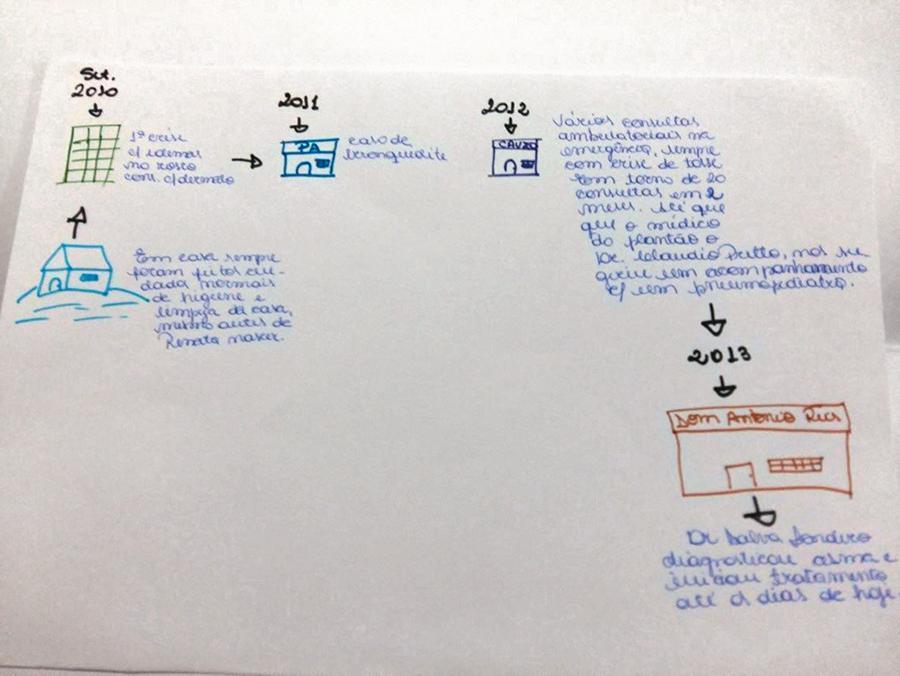
Search
Search in:
Nuvem de Tags
Enfermagem (930)Cuidados de Enfermagem (269)Atenção Primária à Saúde (239)Idoso (208)Educação em Enfermagem (151)Segurança do Paciente (150)Saúde Mental (145)Educação em Saúde (139)Estudos de Validação (131)Qualidade de Vida (104)Tecnologia Educacional (100)Promoção da Saúde (99)COVID-19 (91)Criança (91)Família (87)Enfermagem Pediátrica (86)Saúde do Trabalhador (86)Adolescente (85)Saúde Pública (82)Estudantes de Enfermagem (77)



